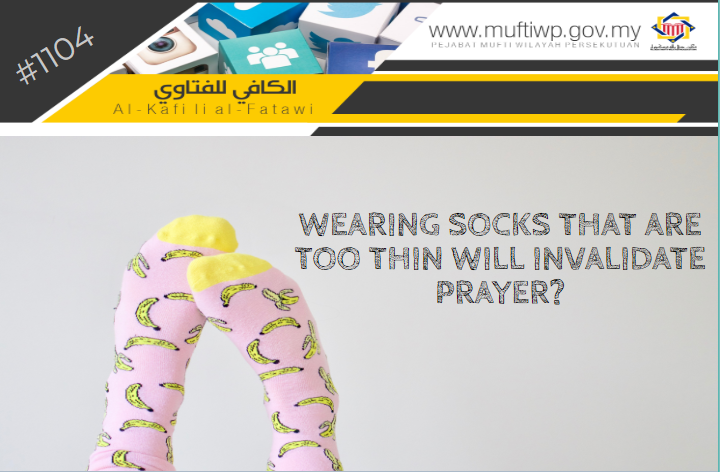Question:
Salam, if a woman's socks are too thin that it shows the color of her skin, will it invalidate her prayer and tawaf? I tried wearing two layers of socks but a faint color of my skin is still seen. Hope for an explanation.
Answer:
Waalaikumussalam wbt,
Alhamdulillah, praise and thanks to Allah for the countless blessings He has blessed us all with. Blessings and salutations to the Prophet Muhammad PBUH, his wives, his family, companions and all those that follow his teachings to the day of judgement.
Among the valid conditions of prayer is to cover the awrah. Which means, a man or woman should cover their awrah when they are praying or else their prayer will be invalid. Awrah for a man is the region from the navel to the knees, while for a woman, it is her whole body with the exception of her face and palms, according to madhhab Syafie. The evidence that support this opinion is a hadith of the Prophet PBUH from Aisyah R.Anha:
لَا يَقْبَلُ اللَّهُ صَلَاةَ حَائِضٍ إِلَّا بِخِمَارٍ
“Allah does not accept the prayer of a woman who has reached puberty unless she wears a veil.”
Sunan Abu Daud (641), Sunan Ibn Majah (655) and Sunan al-Tirmizi (377)
Al-Tirmizi said: “The hadith from Aisyah is a hasan hadith and it can be practiced (and used as an evidence) according to scholars.” Al-Nawawi said, “As for the meaning of a woman who reaches puberty is when a woman who has experienced menstruation.” And it is also a valid condition for men. Refer al-Majmu’ (3/166-167).
The specifications of covering the awrah is explained by Imam al-Syirazi in al-Muhazzab (125/1), “and it is obligatory to cover the awrah that the color of the skin is unseen.”
Syeikh Zainuddin al-Malibari said: “(covering the awrah) is with something that make will conceal the color of the skin (covered and no longer visible) in al-takhatub (one on one conversations).” Refer Fath al-Mu’in (1/86)
The degree of which it can be seen in al-takhatub is explained by Syeikh Abu Bakar al-Dimyati as: “The situation is when someone observes a praying person and come closer to him in order for him to ascertain the color; whether it is the skin’s color, then it does not harm it (the prayer).” Refer I’anah al-Talibin (1/134)
Syeikh al-Syirwani in Hasyiah Tuhfah al-Muhtaj (2/112) also state: “And it does not affect (the validity of prayer) when the color of the skin is visible under light (lamp) or sunlight which is otherwise not visible without light.”
Syeikh al-Nawawi al-Bantani in Kasyifah al-Saja (pg.120) said: “[covering the awrah] with something that can conceal the color of the skin, where the degree of the skin hues, from light to dark is indistinguishable in al-takhatub.”
The term al-takhatub is explained by Syeikh Hasan bin Ahmad al-Kaf in al-Taqrirat al-Sadidah (pg. 84) under the chapter of the washing of beard: “approximately one and a half meters.”
Among the scholars that issued a fatwa through analogical deductions (qiyas) for al-takhatub from the chapter of ablution with awrah is Imam Ahmad bin Musa bin ‘Ajil as stated by the author of Fath al-Muin (pg.86); Hasyiah Tuhfah al-Muhtaj (2/112). However, according to Syeikh Abu Makhramah, in his opinion there is no difference whether it is in al-takhatub or not, but if someone has to observe a clothing closely, then the awrah is considered as not visible. Refer Bughyah al-Mustarsyidin (pg. 104). Wallahua’lam.
After analyzing the above discussion and facts, we are inclined to state:
- It is obligatory to cover the feet for women according to madhhab al-Syafie and it is also a valid condition of prayer. A weak opinion in madhhab Syafie and an opinion in madhhab Hanafi state that a woman’s soles are not awrah in prayer. Madhhab Maliki categorized the sole of the feet as minor awrah and does not affect prayer if it is uncovered. Refer Syarh Yaqut al-Nafis(pg.143-144)
- Wearing thin and thick clothing is a khilaf (difference of opinion by scholars) issue by Syafieyyah scholars. We are inclined towards the explanation of Syeikh Ibn Ajil where it is sufficient to wear clothing that the color of the skin is not visible in al-takhatub, or approximately 1.5 meters between two people who are talking. However, the final opinion is stated by Syeikh Abu Makhramah where he said, it does not specify al-takhatub but just a close observation of the clothing and this is the careful opinion.
- Hence, for women it is permissible to wear socks which will not make the color of the skin visible (where the skin’s hue whether it is light or dark is indistinguishable) in a distance of 1.5 meters in prayer.
- It is sunnah to wear a thick sock or lengthen the telekung (prayer’s cloth) to avoid the khilaf and fitnah. Wallahua’lam.
Hopefully, this explanation will give understanding to the questioner. We end this discussion with the following supplication:
اَللَّهُمَّ أَعِنِّي عَلَى ذِكْرِكَ وَشُكْرِكَ وَحُسْنِ عِبَادَتِكَ
“O Allah help me to remember you, and thank you, and worship you in the best possible way!”


